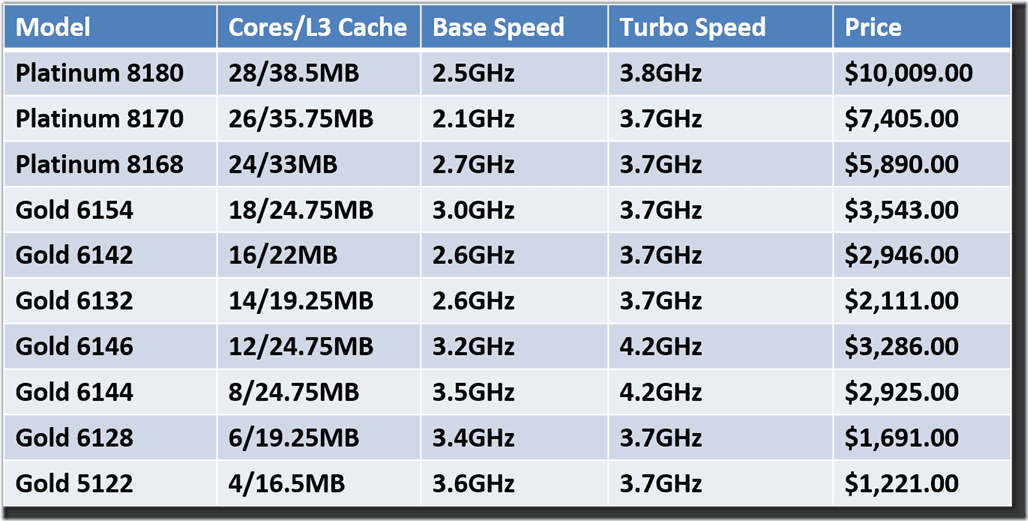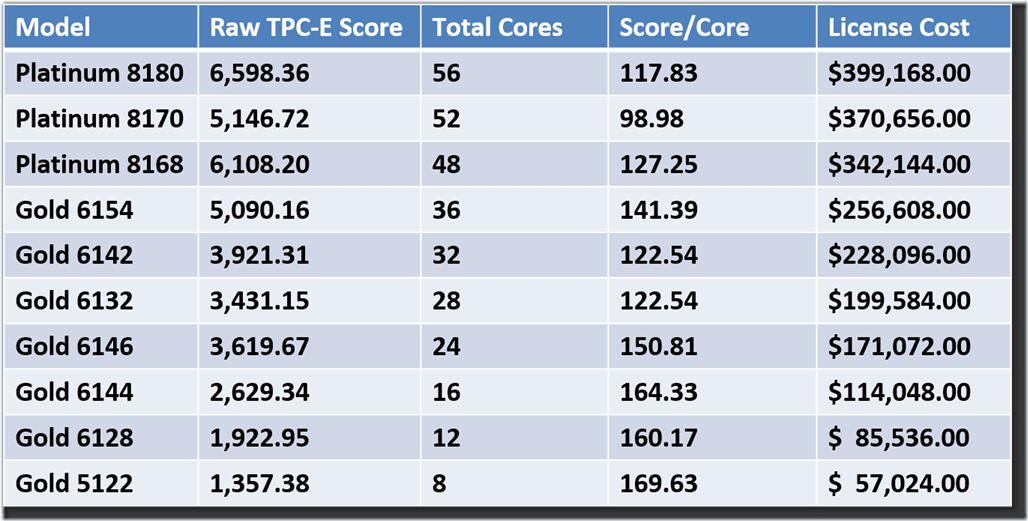On July 11, 2017, Intel formally released their new Xeon Scalable Processor Family of processors for data center usage. This new processor family has a somewhat ridiculous 58 different SKUs in the line. They are broken up into Platinum 8xxx, Gold 6xxx, Gold 5xxx, Silver 4xxx, and Bronze 3xxx sub-categories.
New two-socket server models(which are required for these processors), such as the Dell PowerEdge R740 let you choose from 41 of these available 58 processors (which is also somewhat overwhelming). Microsoft charges the same SQL Server core license prices regardless of the performance of each processor core. Given this, you need to try to pick a particular processor with an awareness of that fact to minimize your licensing costs.
Intel Xeon Bronze and Silver Processors
There are two choices in the Intel Xeon Bronze line, and six choices in the Intel Xeon Silver line. For SQL Server usage, you can and SHOULD ignore those eight processor SKUs from the Bronze and Silver lines. The Bronze processors have low base clock speeds, no Turbo Boost, no Hyper-Threading and low memory speeds. The Silver processors have low base clock speeds and low memory speeds.
Intel Xeon Gold and Platinum Processors
There are 22 different choices between the Intel Xeon Gold 5xxx and 6xxx lines, and 11 different choices in the Intel Xeon Platinum line. Out of these 33 different choices, I think five of them are the “best” choices for SQL Server usage, as measured by their single-threaded CPU performance. Even though these processors are more expensive than the Bronze and Silver lines, the extra hardware cost is a small fraction of the overall system cost, including SQL Server core licenses.
Top Five Intel Xeon Scalable Processors for SQL Server Usage
Here is my top five list, which is ranked by base clock speed and L3 cache size per physical core. Picking a processor from this list is going to give you the best performance for each one of your relatively expensive SQL Server 2016 Enterprise Edition core licenses, which cost $7,128.00 each.
- Intel Xeon Gold 5122 (4 cores)
- Intel Xeon Gold 6144 (8 cores)
- Intel Xeon Gold 6128 (6 cores)
- Intel Xeon Gold 6146 (12 cores)
- Intel Xeon Gold 6154 (18 cores)
Figure 1 shows my “preferred” processor models at each physical core count, along with some of their specifications and their price. Note that I have not included the “M” suffix processor models (which offer double the memory support for a $3,000.00 premium). Depending on your workload, you may want those for SQL Server usage, but I wanted to simplify the table somewhat.
You should also notice the huge premium that Intel charges for the highest core count SKUs, and think about whether that makes sense in your situation. If you can split your workload across multiple servers, you will be much better off from a performance and cost perspective with multiple servers with lower core count processors. Some choices are relatively bad (such as the Platinum 8170) due to their low base clock speeds.
Figure 1: Preferred Intel Skylake-SP Processors for SQL Server Usage
Figure 2 shows some comparative system metrics for a two-socket server with the given processor. These calculations are based on a single actual TPC-E benchmark score for a Lenovo ThinkSystem SR650 server using a pre-release version of SQL Server 2017. I suspect that we will see better results with the release version of SQL Server 2017.
Looking at these numbers, the Raw TPC-E Score is a measurement of the CPU capacity of the system, while Score/Core shows the single-threaded CPU performance for that particular processor. The License cost column shows how much it would cost to purchase SQL Server 2016 Enterprise Edition core licenses for that system.
The first thing jumps out to me is that the Platinum 8170 is a pretty bad choice compared to the Platinum 8168 or Gold 6154. Selecting the Gold 6154 instead of the Platinum 8170 would save you $114,048.00 in SQL Server license costs and $7,724.00 in hardware costs, with roughly the same capacity and much better single-threaded performance (which will be noticeable to your users).
Another good choice would be two database servers with the Gold 6146 instead of one database server with the Platinum 8180. This would save you $57,024.00 in SQL Server license costs and $6,874.00 in CPU costs (which would pay for a good chunk of the second server). Two servers would have more CPU capacity, twice the memory capacity, twice the number of PCIe 3.0 lanes, and much better single-threaded performance.
Figure 2: Comparative Two-Socket System Metrics for Intel Skylake-SP Processors
Additional Resources
My new Pluralsight course, SQL Server: Upgrading and Migrating to SQL Server 2016 has just been published. This is my eleventh course for Pluralsight, but the complete list of my courses is here.
Building on this online course is a new three day class, IEUpgrade: Immersion Event on Upgrading SQL Server, taught by myself and Tim Radney. The first round of this course will be taught in Chicago from October 11-13, 2017.
Finally, I will be presenting a half-day session called Migrating to SQL Server 2017 at the PASS Summit 2017 in Seattle, WA from October 31- November 3, 2017.
Here is a link to the complete series about upgrading SQL Server.



6 thoughts on “Upgrading SQL Server– Top Five Intel Xeon Scalable Processors for SQL Server Usage”
Thanks for the useful info. I can see less cache in the new CPUs. Perhaps the v4 will perform better?
That remains to be seen. The Intel Xeon Scalable processors do have smaller L3 caches, but they are supposed to perform better. They also have larger L2 caches.
Hi Glenn,
Thanks a lot for the information.
Can you please answer few queries,
1. What is the difference between scalable processors and other family since price difference is huge?
2. Cores written in the processor specification are logical or physical cores?
The Intel Scalable processors are the two latest generation of Intel Xeon processors. They have multiple small improvements compared to previous Intel processors. They are more expensive because Intel decided to charge more for them. Intel specifies both the number of physical and logical cores in their specifications.
Would you recommend going for a Xeon Gold 5122 with 4 cores, or a Xeon Silver 4215 with 8 cores? Which would give better performance – clock speed or core count, for heavy SQL loads?
You should never consider using an Intel Xeon Silver processor for SQL Server usage. You give up too much clock speed, L3 cache size and UPI bandwidth for a tiny hardware savings. I would much prefer the Xeon Gold 5122 over the Silver 4215. You should actually get the newer Gold 5222 rather than the Gold 5122.